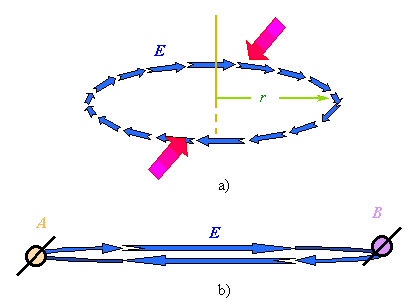SELF |
78 |
S.B. Karavashkin and O.N. Karavashkina |
|
|
|
SELF |
78 |
S.B. Karavashkin and O.N. Karavashkina |
|
|
|
As we said above, the experiments with the air-core transformer gave us the answer, are the lines of force of magnetic field closed or not, but they remained without answer the question, how occurs the process of energy transmission between the primary and secondary loops. To find an answer, let us recall that according to the conventional concept, description of induction consists of three sequential stages:
The value of emf of induction is found on the basis of Faraday law in the mathematical form by Maxwell - Hertz which has the following integral form: |
|
|
(5) |
where In such representation, "the conductor, i.e. the wire loop, is some absolutely insufficient and side. In essence, the process absolutely does not depend on the occasional presence of the wire turn. It consists in, around the varying magnetic field there arise the closed lines of electric field" [5, p. 117]. "The formula (5) is the generalised Faraday induction law (1831). The generalisation lies in the following: the Faraday's experimental data belonged to the loop of wire (metallic) conductor. The current appearing in the loop that has been measured directly corresponds to the appearance in the wire of the induced electric field" [6, p. 33]. Let us concentrate our attention on these last theses which currently seem doubtless for scientists and engineers. It follows from these theses, if we diminish the cross-section of loop making it, for example, elliptic, the emf of induction has to diminish inevitably, as the cross-section of secondary loop diminishes. In the limit we will obtain the loop of infinitesimal cross-section - it means, the emf registered at the opposite sides of this loop has to be zero! We can easy demonstrate it with the model of closed dynamic electric field shown by Purcell (see Fig. 9). |
|

|
Fig. 9. Electric field at the circular path C:
|
In the above of Fig. 9 we show the Purcell's representation taken from [1, p. 248, Fig. 7.18 a]. If now we compress the loop in the direction indicated by red arrows which we added to this picture, in the limit we will yield the loop shown in Fig. 9, bottom. Naturally, with the homogeneous material of loop and homogeneous magnetic field affecting this compressed loop, the difference of potentials taken from the points A and B obviously has to be zero. Going on compressing the loop, we naturally will come to a single wire in the dynamic magnetic field. If we, for example, create some local region of homogeneous dynamic magnetic field (e.g., in a narrow gap between the poles of ferromagnetic core) and place into this field a single wire as a probe, then, because the region is local, the secondary loop (that is shown as blue arrows) in which the emf could induce will be limited by the size of region and cross-section of the wire, as it is shown in Fig. 10. |

|
Fig. 10. Model of the secondary loop arrangement in the single conductor placed into the local dynamic magnetic field B
|
If the wire had a small cross-section, the frequency of magnetic field is small (to avoid the skin effect in the probe) and the conductor is homogeneous in its cross-section, then according to the conventional phenomenology of induction process, the emf at the ends of this conductor will be zero. This is easily checkable experimentally. |
Contents: / 72 / 73 / 74 / 75 / 76 / 77 / 78 / 79 / 80 / 81 / 82 / 83 / 84 / 85 / 86 / 87 / 88 / 89 / 90 /